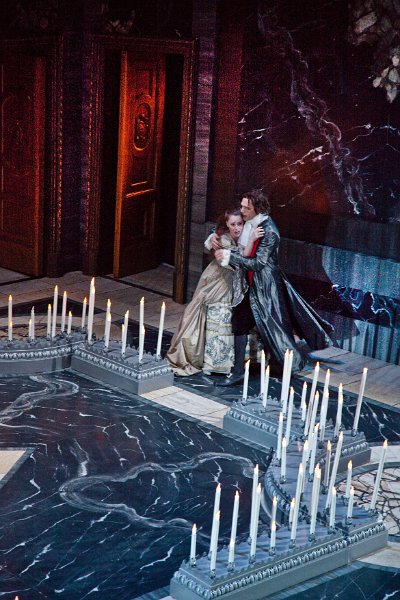J-B. Lully, Atys: Soloists, Les Arts Florissants, William Christie (conductor). Grand Théâtre de Bordeaux. 19.6.2011 (JMI)
Coproduction Opera Comique, Brooklyn Academy of Music, Théâtre de Caen, Opera National de Bordeaux, Les Arts Florissants
Direction: Jean-Marie Villégier
Sets: Carlo Tommasi
Costumes: Patrice Cauchetier
Lighting: Patrick Méeüs
Choreography: Francine Lancelot (original), Beatrice Massin (revival)
Wigs: Daniel Blanc
Cast:
Atys: Ed Lyon
Cybèle: Stéphanie d’Oustrac
Sangaride: Emmanuelle de Negri
Celenus: Nicolas Rivenq
Idas: Marc Mauillon
Doris: Sophie Daneman
Melisse: Jaël Azzaretti
Dieu du Sommeil: Paul Agnew
Morphée: Cyril Auvity

Jean Baptiste Lully (*Florence 1632 – †Paris 1687) is one of the most significant musicians of the 17th century – and the most important one during the days of Louis XIV, who put all of Versailles’ means at Lully’s disposal for the glory king, country. Mostly king, though.
Lully can be considered the true creator of the genre of musical tragedy, so peculiarly French an art, and his music is much closer to Monteverdi than to baroque. Atys is the fourth of his operas or ‘tragedies in music’, and premiered in 1676 with a tremendous success. Its libretto is by Philippe Quinault and narrates the tragic love of Atys and Sangaride, ending with the death of the girl at the hands of her lover while temporarily confused by goddess Cybele (who is also in love with Atys). When Atys realizes what he did to his beloved Sangaride, he attempts suicide; Cybele now full of regret turns dying Atys into a pine tree. The opera ends with the lament of the goddess Cybele, a moment of great intensity and musical beauty.
 Lully, Atys, W.Christie / Les Arts Florissants et al. (1987) Harmonia Mundi |
Following the success of its premiere, Atys mostly was forgotten until 1985, when William Christie and Jean-Marie Villegier revived it, with the considerable support of Opera-Comique. The production had its premiere at Prato’s Teatro Metastasio (Lully was born in Florence) in late 1986, before being offered at Paris Salle Favart in early 1987. (The same year Harmonia Mundi recorded the ensemble in what became a landmark recording.) The success of those performances were huge and subsequently it was shown in various cities, both in Europe and the US, having arrived in 1992 at Madrid Teatro de la Zarzuela in one of the last opportunities that this production could be seen. I was most fortunate to have attended one of these performances in Madrid and I was amazed by the whole production.
Now that old production is being revived with the special support of American businessman and philanthropist Ronald P. Stanton. The impact that Atys had on him in the 80’s was such that he always desired not to die without seeing it again. He persuaded William Christie to re-create the production, including, of course, the magnificent costumes. This reconstructed production was premiered at Paris Salle Favart last month and was a huge success once again. Now the production is on tour, having already visited Caen (home of Les Arts Florissants) and having now reached Bordeaux where its theater director, Thierry Fouquet, was one of the collaborators in the early rediscovery of the opera. Next month it will be seen at Versailles. September 18th through 24th it will be shown in New York at the Brooklyn Academy of Music, where Ronald P. Stanton is on the board.
The production by Jean-Marie Villegier remains of unquestionable beauty, combining in a perfect way drama and dance. The stage offers an impressive reconstruction of a space at Versailles. Costumes are simply spectacular, well in line with the Court of Versailles under Louis XIV, with the wigs particularly outstanding. The lighting complements this brilliant production perfectly, as does an excellent choreography. It is not easy in an opera like this to keep the attention and the interest of the public, but Jean-Marie Villegier does just that. It remains one of the most brilliant stage shows that can be seen today… it just happens to be opera.
The immense musical ability of William Christie and Les Arts Florissants is widely known and was in full show again. When I saw this production in 1992, he was unknown in Spain and an opera of the 17th century was something quite exceptional. Following this performance of Atys in Bordeaux I realized that today Baroque is served quite well, with excellent orchestras and conductors specialized in the genre. But even with so much more competition, Bill Christie still plays in a different league, producing musical performances that always will be remembered. Les Arts Florissants (Orchestra and Choir) are a perfect complement to this immense musicality and exceptional artistry.
The cast did not offer flashy names, which are in any case not needed in an opera of this type. What was offered was musicality and good taste in all cases. None of the 20 solo performers was a weak interpreter. Among them I should point out the excellent Atys by Ed Lyon, as well as French mezzo soprano Stephanie d’Oustrac, who was a moving Goddess Cybele. It was excellent soprano Emmanuelle de Negri in the part of Sangaride, the unfortunate young woman in love with Atys. In Atys’s sleep scene, induced by the goddess, there were excellent interventions from Paul Agnew as the God of Sleep and Cyril Auvity as Morphée. Nicolas Rivenq repeated his interpretation of Celenus from the 80’s.
There have been only three performances of this opera in the beautiful Grand Theatre and it was fully sold out, being obviously the success of the season.
José MªIrurzun